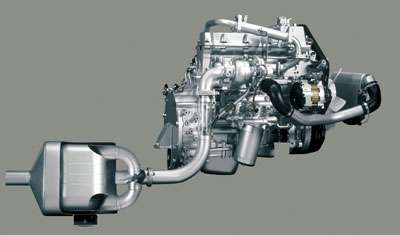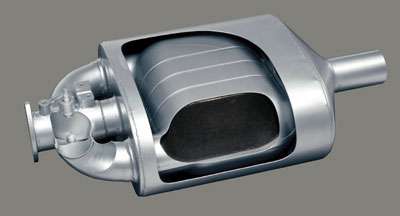The new diesel purification system currently
under field tests with selected Toyata Avensis customers in a number of
European countries is aimed at overcoming what the company refers to as
the 'final obstacle' to clean diesels. The DPNR converter features a newly
developed, highly porous ceramic filter coated with a catalyst exclusively
developed by Toyota for its NOx storage reduction catalytic converter,
initially designed for use with Toyota's lean-burn (high-oxygen) gasoline
engines.

The Diesel Particulate-NOx
Reduction system (DPNR) reduces particulates and NOx simultaneously,
brings emissions to well below Euro Step IV levels, and is
servicing-free.
The launch of DPNR is yet another chapter in
Toyota's long history of developing technology for cleaner diesel engines
by using catalytic converters and improved combustion technologies, such
as direct fuel injection, electronically controlled exhaust gas
recirculation (EGR) and, most recently, high pressure common rail fuel
injection.
The widespread commercial introduction of DPNR,
following successful field trials, is likely from next year, and would
eliminate one of the few remaining possible objections to diesel as an
environmentally clean fuel.
A fleet of 60 Toyota Avensis 2-litre
D-4D models were offered to selected customers in Germany, UK, Austria,
Italy, Norway, Finland and Belgium. These customers are involved in a wide
range of commercial activity.
The world's first common rail diesel
system, developed by Toyota subsidiary company Denso, was introduced for
truck application in 1995. In 1999, Toyota and Denso introduced the system
to passenger cars and, such is the pressure for improved environmental
control, the majority of diesel engines are forecast to use common rail by
2004.
Now a second generation common rail system, capable of rail
pressures of 180 MPa, is complementing the DPNR technology. A high
response, large amount flow, high resolution EGR system has been added to
create low temperature combustion, itself a factor in greatly reducing the
base emission levels from the engine.
The DPNR catalytic converter
is mounted close to the exhaust manifold and a simple oxidation catalytic
converter is further downstream in the exhaust system.

In the DPNR purification process, during conventional
lean-burn combustion, particulate matter is first oxidised using active
oxygen which has been created when NOx is temporarily stored inside the
catalytic converter.
Then, when the engine momentarily switches to
low-oxygen stoichiometric (rich) combustion – through a 'rich spike'
exhaust port injection - the stored NOx is reduced producing more active
oxygen. This additional oxygen is used to further oxidise particulate
matter inside the catalytic converter.
Unlike other particule
filters, it is servicing-free, meaning that during the entire vehicle's
life is not scheduled a periodic replacement of any of DPNR's components
and it doesn't require the use of any fuel additive.
For maximum
effect and to avoid catalyst deterioration, DPNR requires the use of
diesel fuel with less than 10ppm of sulphur, which is currently being
introduced across many countries in Europe.
Более 2000 руководств
по ремонту и техническому обслуживанию
автомобилей различных марок


